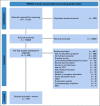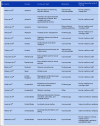Synthesis of Existent Oncology Curricula for Primary Care Providers: A Scoping Review With a Global Equity Lens
- PMID: 37141562
- PMCID: PMC10281448
- DOI: 10.1200/GO.22.00298
Synthesis of Existent Oncology Curricula for Primary Care Providers: A Scoping Review With a Global Equity Lens
Abstract
Purpose: Global increases in cancer, coupled with a shortage of cancer specialists, has led to an increasing role for primary care providers (PCP) in cancer care. This review aimed to examine all extant cancer curricula for PCPs and to analyze the motivations for curriculum development.
Methods: A comprehensive literature search was conducted from inception to October 13, 2021, with no language restrictions. The initial search yielded 11,162 articles and 10,902 articles underwent title and abstract review. After full-text review, 139 articles were included. Numeric and thematic analyses were conducted and education programs were evaluated using Bloom's taxonomy.
Results: Most curricula were developed in high-income countries (HICs), with 58% in the United States. Cancer-specific curricula focused on HIC priority cancers, such as skin/melanoma, and did not represent the global cancer burden. Most (80%) curricula were developed for staff physicians and 73% focused on cancer screening. More than half (57%) of programs were delivered in person, with a shift toward online delivery over time. Less than half (46%) of programs were codeveloped with PCPs and 34% did not involve PCPs in the program design and development. Curricula were primarily developed to improve cancer knowledge, and 72 studies assessed multiple outcome measures. No studies included the top two levels of Bloom's taxonomy of learning (evaluating; creating).
Conclusion: To our knowledge, this is the first review to assess the current state of cancer curricula for PCPs with a global focus. This review shows that extant curricula are primarily developed in HICs, do not represent the global cancer burden, and focus on cancer screening. This review lays a foundation to advance the cocreation of curricula that are aligned to the global cancer burden.
Conflict of interest statement
The following represents disclosure information provided by authors of this manuscript. All relationships are considered compensated unless otherwise noted. Relationships are self-held unless noted. I = Immediate Family Member, Inst = My Institution. Relationships may not relate to the subject matter of this manuscript. For more information about ASCO's conflict of interest policy, please refer to
Open Payments is a public database containing information reported by companies about payments made to US-licensed physicians (
Figures










References
-
- Sung H, Ferlay J, Siegel RL, et al. Global Cancer Statistics 2020: GLOBOCAN estimates of incidence and mortality worldwide for 36 cancers in 185 countries. CA Cancer J Clin. 2021;71:209–249. - PubMed
-
- Kirkwood MK, Bruinooge SS, Goldstein MA, et al. Enhancing the American Society of Clinical Oncology workforce information system with geographic distribution of oncologists and comparison of data sources for the number of practicing oncologists. JCO Oncol Pract. 2014;10:32–38. - PubMed
-
- Rubin G, Berendsen A, Crawford SM, et al. The expanding role of primary care in cancer control. Lancet Oncol. 2015;16:1231–1272. - PubMed
Publication types
MeSH terms
LinkOut - more resources
Full Text Sources
Medical

